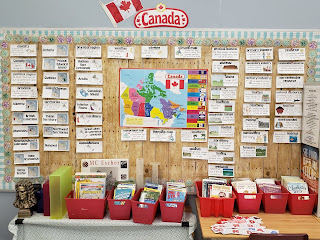3 Tips for Using Word Walls in Elementary Social Studies
I am a huge fan of word walls in any class, and have happily created walls for each math unit, science strand, and novel study I undertook. Social studies is my particular love, though, and I find that students can struggle without concrete strategies being provided to help them master the content vocabulary. A word wall is a quick and easy tool to make students comfortable with the new words and terms they encounter.
Here are 3 tips to help make the most of any word wall in Grades 4-7.
1. Display Strategies
a) Word/Phrase + Definition + Image = Comprehension
Students do best when they can see an image related to a word or phrase, and are provided with a short definition.
b) Arrange by topic. In the image here, you can see that an upcoming municipal election is being studied by the class, and images of the candidates are displayed, as well as election terminology.
c) Consider individual word walls for some students. Students who struggle to maintain concentration when using a word wall on a bulletin board may do better with some key vocabulary gathered on a ring or in a folder.
2. Play Games!
A word wall should never be a stagnant display, but a living tool in your classroom. When you have a few extra minutes before it's time to go home, play one of the following games using the word wall.
a) Hangman: the traditional game, but students know ahead of time that each word is one that is already displayed in the room.
b) 5 Clues: Choose a word card ahead of time, and create five clues that students can use to figure out what word card you have chosen. Read one clue at a time, and have students use each clue to determine what card you've chosen. They win if they can guess the card before you have given all the clues. For example, for the word "foothill", for example, the clues could be:
2. It is a compound word.
3. It can be found in the environment.
4. It is a land feature.
5. It has two sets of double letters.
c) Bingo with Clues: Distribute blank 5 x 5 (or 4 x 4 or 3 x 3) bingo cards to your students. Have them fill in each box with a word or phrase from the word wall. Without calling out the actual word wall words themselves, give them a clue. For example, for "elder", you could say "this is a word that describes a wise person in the community".
3. Have Students Choose Some Words
Sometimes we assume students understand some vocabulary that seems very basic to us, and then find out we were wrong. Having some blank word wall words available for those moments will allow you to grab that "teachable moment" and have a willing student create the word wall card for such vocabulary. Having word wall words made by students makes the wall more meaningful and useful to them!
Click on the image here to get your FREE Canadian Government Word Wall Sampler!
Check out my line of Ontario Social Studies Curriculum word wall resources here.




